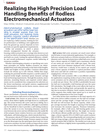Lead screws: Also, known as acme screws or trapezoidal screws, these deliver rigidity and high thrust in a small package. The action between the screw and nut is sliding, has a high friction factor and is inefficient, although it sometimes can be beneficial in that it provides a self-locking tendency when the system is at rest. Increasing clearance caused by wear between the screw and nut will determine the usable life of the actuator. Some vendors, however, now outfit actuators with plastic, self-lubricating nuts, which extends their lives.
The pressure velocity (PV) limit is another factor impacting lead screw load and speed ratings. Pressure equates to thrust, so as the thrust goes up, the speed goes down and vice versa. Lead screw actuators can have strokes as long as three meters but are most often found in smaller, lighter-duty applications.
Ball screws: Ball screw actuators are much more robust and fit better in most industrial applications. For example, a ball screw actuator built on a 120 mm extrusion with a 32 mm diameter and a 20 mm lead precision rolled ball screw would have a thrust capacity of 12,000 N and a maximum velocity of one meter per second with 3,000-rpm input. The same actuator and screw diameter deployed with a 40 mm lead, however, would have a velocity of two meters per second and a thrust capacity of 8,000 N. A typical precision rolled ball screw and ball nut could have a position repeatability ranging from ±.01 mm or less.
Rolled ball screw actuators offer a cost-efficient solution for applications requiring strokes of up to three meters. Ball screw actuators can be selected to optimize power density or small size per thrust. The L10 life is predictable because the ball nut is essentially a ball bearing and uses the same ISO calculation. The length of the screw affects the load rating, due to the buckling limit, and generally the speed rating, due to excessive vibration. Some vendors, however, add screw supports that enable input speed up to as much as 3,000 rpm, independent of the screw length.
Two other factors that contribute to the load capacity of a ball screw driven rodless actuator are the ball nut arrangement and the carriage length. A longer ball nut or a double ball nut will increase the thrust capacity, while a longer carriage increases the length or spacing of the bearings and increases the moment capacity. Thomson Industries, for example, offers a ball screw, ball bearing guide actuator with a single or double ball nut. The single nut version of its 80 mm × 80 mm profile unit has a 200 mm — long carriage, a thrust capacity (FX) of 3,500 N and a pitch moment (My) of 180 Nm. The corresponding double nut version has a 280-mm-long carriage, a thrust capacity (FX) of 5,000 N, and a pitch moment (My) of 300 Nm. The double nut is also more rigid and will have a slightly better repeatability and reduced axial play.
Timing belt thrust mechanisms: These actuators are also robust and fit in most industrial applications. Actuators equipped with high tensile strength timing belts can handle large thrust loads, velocities up to 10 m/s and are almost unlimited in length. For applications requiring strokes of more than three meters, they are more cost-effective than rolled ball screw actuators. Timing belt actuators are also clean and contaminant-resistant. A timing belt mechanism built on the same 120 mm extrusion as a ball screw would have a thrust capacity of 5,000 N with a 2,308 rpm input and velocity of 10 m/s. The belt travel would be 260 mm per pulley revolution with ±.05 mm position repeatability.
Selecting guide systems
Careful specification of the guide systems that support the carriage and all the forces acting on the attached load as it travels is another critical success factor for rodless actuators. These can be specified with plain bearings, ball bearings, cam followers and/or wheels.
A motorized lead screw offers increased torque density and improved operating battery life.
Plain bearings: These will have a higher friction factor than the rest, however, they often do not require lubrication and can survive in contaminated or wet environments. Plain bearings also dampen vibration, run quietly and can tolerate short strokes at high cycles. Plain bearings or slide guides run either along the aluminum extrusion or are on a set of rails formed into the extrusion. They can be made of different materials such as hardened steel, stainless steel or anodized aluminum. The plain bushings could also be made of a number of materials, including polymer material, PTFE and many low-friction plastics.
Ball bearing guides: These guides consist of recirculating ball bearings attached to the carriage. The carriages run on hardened steel rails, which are bolted onto extrusions or steel inserts. The actuators in discussion can use a single profile rail for lighter load requirements, or add an additional rail for applications requiring higher loads and or moment capacity. Ball guides offer high accuracy, high load ratings and medium speeds.








 Power Transmission Engineering is THE magazine of mechanical components. PTE is written for engineers and maintenance pros who specify, purchase and use gears, gear drives, bearings, motors, couplings, clutches, lubrication, seals and all other types of mechanical power transmission and motion control components.
Power Transmission Engineering is THE magazine of mechanical components. PTE is written for engineers and maintenance pros who specify, purchase and use gears, gear drives, bearings, motors, couplings, clutches, lubrication, seals and all other types of mechanical power transmission and motion control components.